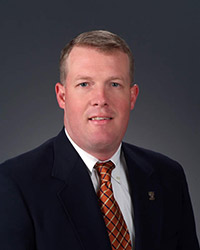Davidson Brings Big Ideas to Large Animal Clinical Staff at Texas A&M CVM
COLLEGE STATION, TX – It’s been called the toughest job you will ever love, and yet in spite of the many rewards, there remains a national shortage of rural veterinarians.

Texas A&M University College of Veterinary Medicine Biomedical Sciences is committed to spreading the word to current and prospective veterinary medical students about the opportunities that can be found in this challenging line of work.
The first step was hiring Dr. John Davidson, an Aggie and former practicing veterinarian, to join the Food Animal Section of the Department of Large Animal Clinical Sciences at the CVM.
“Today’s students need to be told about the best kept secret in all of veterinary medicine – mixed animal practitioners have more fun,” says Davidson. “The variety and opportunities (both medical and surgical) available to today’s progressive mixed animal practitioner are beyond compare. If more graduates would just give it a try, many would find these opportunities and lifestyles are very inviting. There are tremendous practice opportunities in these communities and the clientele are so appreciative.”
And Davidson should know. He returns to A&M, where he received both his undergraduate and veterinary medical degrees, from a successful mixed animal practice that boasted two clinics in Caldwell County. Leaving his practice and the strong relationships he had with his business partner and very talented associate veterinarians was a difficult choice, but Davidson realized that he had a calling to work with students – perhaps making a small impact on the rural practitioner shortage by being able to share his experience and passion for the job with them.
“One of my many goals while here at Texas A&M is improving the awareness and correcting some of the negative stigmas that are often times incorrectly applied to rural/mixed or ‘general’ veterinary medical practice,” said Davidson. “A key advantage, that often goes unnoticed, of entering mixed practice, even if for a short time, is the solidification of the broad, vast, general knowledge that all veterinary students get. Because of the foundation and implementation of my education as a mixed or general practice veterinarian, I know that after spending significant time away from my practice, I feel confident that I could successfully return to private practice at any point in the future.”
Davidson acknowledges that some of the biggest challenges mixed animal veterinarians face are the different level of management intensity and sophistication among today’s cattle producers. This poses a challenge to all charged with providing a wholesome product to an increasingly conscious beef consuming public.
“Cattle producers and veterinarians still need to have a close and productive relationship, and the consumers want to know that the product is safe and wholesome,” said Davidson. “In this way, veterinarians, working closely with the producers, play a significant role in the safety of our food supply. We also need to let producers know that when they make a choice to use Texas A&M for their veterinary medical services, they are having a profound effect on the future of veterinary medicine by creating positive exposures and experiences for our students. The more this happens, the more likely we are to increase the number of students who would choose to go into mixed or general practice.”
Davidson’s enthusiasm for working with cattle and cattle producers began at an early age, and that passion was nurtured by his hometown veterinarians.
“Dr. Davidson has a lot of energy, and has already begun to outline a very ambitious set of goals for the program,” said Dr. Dan Posey, chief of food animal medicine at Texas A&M. “We couldn’t have found a more dynamic individual to introduce our students to mixed animal practice. We’re very excited he’s on board and expect great things to come.”


